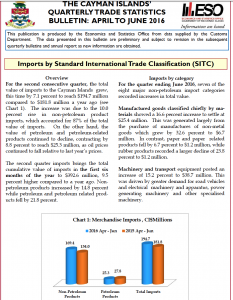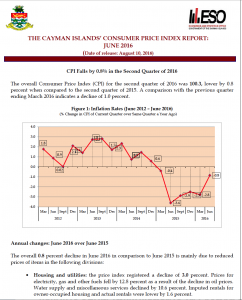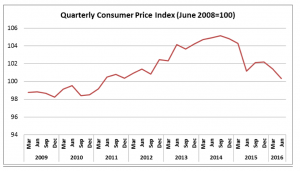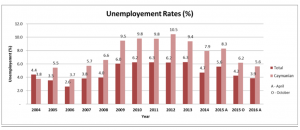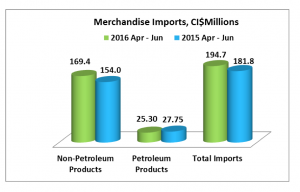ESO reports show improvements in Cayman Islands cost of living, employment and imports
 The Economics and Statistics Office (ESO) has just published three important reports highlighting the current state of the Cayman Islands economy:
The Economics and Statistics Office (ESO) has just published three important reports highlighting the current state of the Cayman Islands economy:
- The Cayman Islands’ Consumer Price Index Report: June 2016
- The Cayman Islands’ Labour Force Survey Report: Spring 2016
- The Cayman Islands’ Quarterly Trade Statistics Bulletin: April to June 2016
These reports provide critical information on the health of the economy by providing details on the overall change in the cost of living or inflation; the state of employment; and general level of economic activity.
“Collectively, the reports confirm that based on the major indicators the Cayman Islands economy is performing well and poised for further improvement this year. Currently, inflation is under control, more persons are being employed and there is increased spending and investment within our economy” said Honourable Marco Archer, Minister for Finance and Economic Development.
The Cayman Islands’ Consumer Price Index Report: June 2016
This report measures inflation (Consumer Price Index – CPI) in the Cayman economy by measuring changes in prices for goods and services purchased by households over a particular period.
For the second quarter of 2016 (1 April – 30 June 2016) the CPI declined by 0.8 percent when compared to the same period in 2015.
Minister Archer went on to explain the results of the CPI Report: “This means that generally the cost of living has decreased and persons have a bit more disposable income that they can choose to spend as they wish or increase their savings. Lower fuel prices pushed down the average charges for, electricity, water and related services, gas and other fuels, as well as the cost of operation of personal transport equipment.”
The Cayman Islands’ Labour Force Survey Report: Spring 2016
The overall unemployment rate in the Cayman Islands declined to 3.9% in Spring 2016 when compared to the 5.6% overall rate reported in Spring 2015.
Employment among Caymanians had the highest growth of 6.7% (or 1,174 persons). Non-Caymanian employment also increased by 6.4% (or 1,061 persons). The total increase in employment for Permanent Residents with rights to work (PR-WRW) was 2.0% (or 78 persons). Total employment during the period increased by 2,313 to reach 40,213 persons.
The Caymanian unemployment rate dropped from 8.3% in Spring 2015 to 5.6% in Spring 2016. The number of unemployed Caymanians settled at 1,111 compared to 1,575 a year ago.
“Employment statistics are an excellent benchmark of economic well-being of any economy. The 3.9% total unemployment rate is the lowest since 2007, with a high of 6.3% in 2011 and 2013, and indicates that we have a vibrant economy that is creating jobs. I am particularly pleased to see that employment amongst Caymanians has registered the highest rate of growth,” said Minister Archer. “This is a significant achievement considering that in 2012, the unemployment rate for Caymanians was 10.5%,” he further stated.
The Cayman Islands’ Quarterly Trade Statistics Bulletin: April to June 2016
The total value of goods imported to the Cayman Islands from abroad in the second quarter of 2016 amounted to CI$194.7 million.
When compared to the same period in 2015, the second quarter imports represent a 7.1% increase. Similar to the first quarter of 2016, the rise in importation was primarily due to non-petroleum products which amounted to CI$169.4 million. Among these goods are capital goods such as electrical machinery and apparatus, power generating machinery and other specialized machinery. Transport and equipment parts and accessories also recorded a strong growth of 17.7%.
The total value of petroleum imports continued to decline in the second quarter to settle at CI$25.3 million. The reduction was due to lower prices while total quantity of these products recorded a 6.8% increase.
“The level of imports is a key economic indicator for the Cayman Islands as we have very little local manufacturing to speak of and are dependent upon imports to meet our needs. The increased level of capital goods imported indicates that businesses are making investments in new and improved infrastructure thereby strengthening their commitment to the Cayman Islands and positioning themselves for future growth in their respective sectors. This future growth will also help to create more job opportunities with the within the economy.” said Minister Archer. “
For more information on any of the three above reports, please visit the ESO website www.eso.ky.

